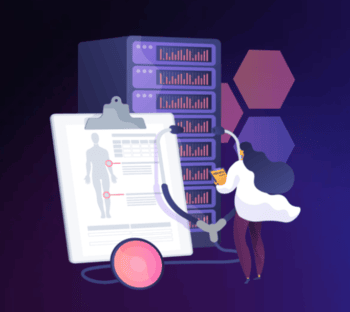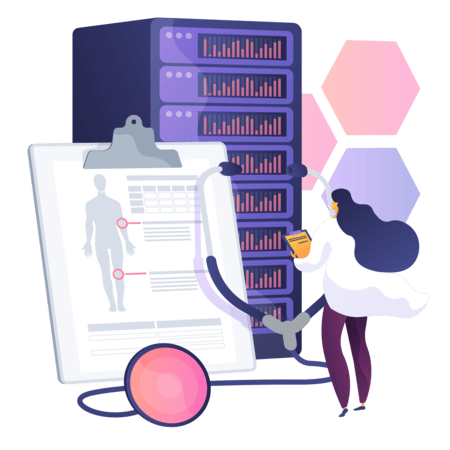
Bridging Healthcare Data Silos: The Key to Better Patient Outcomes

By Teqfocus Team
3rd April, 2025
Through our work with healthcare organizations and conversations with industry leaders, we recognize that fragmented data remains a significant challenge. Siloed systems, disconnected records, and inconsistent data formats create barriers to seamless care coordination and operational efficiency.
Addressing these challenges through interoperability and data unification is not just a technical imperative – it’s a strategic one. It is critical to ensuring healthcare professionals have access to the right information at the right time, ultimately improving patient outcomes and operational agility.
The Challenge: Fragmented Data, Disconnected Care
1. Lack of Standardization
Healthcare data exists in multiple formats across different systems, making it difficult to share and interpret. EHRs, billing systems, pharmacy records, and lab databases often operate in isolation, limiting clinicians’ ability to provide holistic patient care.
This lack of standardization is more than a nuisance – it has a direct impact on healthcare quality. According to a recent study by the Journal of the American Medical Informatics Association (JAMIA), nearly 70% of clinicians report difficulty accessing complete patient information due to non-standard data formats.
The cost of this fragmentation is staggering. A McKinsey report estimates that inefficient data sharing contributes to over $265 billion in unnecessary healthcare spending each year in the U.S. alone.
2. Interoperability Barriers
Many healthcare organizations still struggle with interoperability, leading to persistent data silos. This hinders real-time access to patient information and contributes to critical issues such as;
- Redundant tests
- Delayed treatments
- Miscommunication between providers
Gartner highlights that only 40% of healthcare organizations have a mature interoperability strategy in place. And yet, the push toward value-based care depends on real-time, coordinated, and longitudinal patient views – something siloed systems simply cannot provide.
3. Limited Data Access
Patient information is often dispersed across multiple platforms, from hospital EMRs to insurance databases, from wearable devices to remote care apps. This dispersion leads to clinical blind spots. Without a single source of truth, decision-making is fragmented.
In fact, a 2024 Forrester study revealed that 52% of health system executives believe lack of integrated data is the biggest barrier to delivering effective care.
The Solution: Enabling Seamless Data Exchange
1. Adopting HL7 and FHIR Standards
Standardized data exchange protocols like HL7 and FHIR (Fast Healthcare Interoperability Resources) have emerged as the backbone of interoperability. These standards allow disparate systems to “speak the same language” – enabling effective data sharing and reducing duplication.
FHIR adoption is gaining significant momentum. As of 2024, 90% of U.S. hospitals have systems capable of sending and receiving FHIR-based data, thanks to CMS interoperability mandates.
These standards are not just technical enhancements – they lay the foundation for coordinated care, remote monitoring, and AI-driven clinical insights.
2. Leveraging Data Unification Platforms
Modern cloud-based platforms like Salesforce Data Cloud are transforming how healthcare organizations centralize patient data. These platforms integrate information from EHRs, CRM systems, labs, and IoT devices into a unified patient profile.
Take the example of UC Health, which used Salesforce Health Cloud to integrate over 15 disparate systems – reducing data redundancy by 60% and increasing care plan adherence by 22%.
Unified data enables richer patient insights, smarter segmentation, and more proactive care.
3. Real-Time Data Integration with APIs
Application Programming Interfaces (APIs) are the enablers of dynamic, real-time data flows. Platforms like MuleSoft, an integration engine also under Salesforce, make it possible to seamlessly connect EHRs with insurance databases, scheduling tools, and analytics dashboards.
Mount Sinai Health System used API-driven architecture to connect legacy EMRs with new AI platforms, reducing patient intake time by 40% and improving care coordination across departments.
The Impact: Improved Care Coordination and Patient Outcomes
1. Enhanced Decision-Making
Unified patient data provides clinicians with a 360-degree view of medical history, current vitals, lab results, and care plans – enabling smarter, faster decisions.
According to a study published by the National Institutes of Health, clinicians with access to integrated patient data made 37% fewer diagnostic errors, and saw faster treatment decisions by up to 20%.
With AI embedded into these data-rich systems, decision support becomes predictive, not just reactive.
2. Operational Efficiency
Interoperability and automation reduce administrative workload. Real-time data exchange streamlines billing, referrals, scheduling, and reporting – allowing care teams to spend more time with patients and less time navigating broken systems.
A Deloitte study estimates that workflow automation and unified data can save healthcare systems an average of $12 million annually in administrative costs.
3. Patient-Centric Care
Today’s patients expect connected, personalized experiences across digital and in-person touchpoints. When systems are integrated, providers can offer continuity across primary care, specialists, diagnostics, and follow-ups.
The result? Higher patient satisfaction scores, improved medication adherence, and a tangible shift toward proactive care.
Kaiser Permanente, a long-time leader in integrated care, attributes much of its 94% member satisfaction rating to its ability to unify data and deliver coordinated, seamless care.
The Future: A More Connected Healthcare Ecosystem
Healthcare data silos are no longer just an IT challenge – they are a business and clinical risk. They impair everything from care quality to financial performance. But the tide is turning.
With increasing regulatory pressure, evolving patient expectations, and rapid cloud adoption, we are at the cusp of a healthcare transformation. Leading organizations are already rethinking their data strategy and interoperability frameworks.
The path forward lies in;
- Embracing standards like FHIR for scalable exchange
- Investing in platforms that unify and operationalize data
- Building API-first architectures for future flexibility
By adopting these principles, healthcare organizations are not only preparing for compliance – they’re unlocking clinical and competitive advantages.
Conclusion: Transformation with Purpose
The shift toward unified data is already underway. But it’s not just about technology – it’s about empowering people. Healthcare leaders must take proactive steps to ensure that technology enhances collaboration, not complexity.
Let’s move toward a future where data flows freely, securely, and intelligently – improving outcomes for both patients and providers.
Are you ready to break down the silos and build a connected healthcare future?
Let’s start with a quick strategy session to map your interoperability journey.
